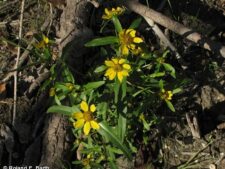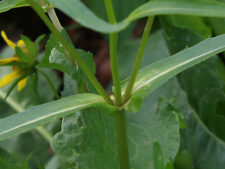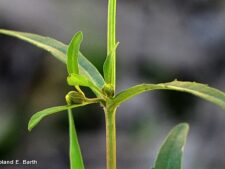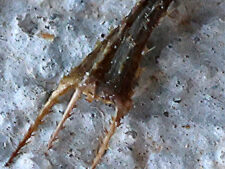
BUR MARIGOLD
Bidens cernua
SUNFLOWER FAMILY (Asteraceae)
 Identification
Identification
- Flowering Time - August, September, October
- Common in wet floodplain sites at FF; uncommon along creek at NW
- Our only Bidens species with showy yellow ray florets
- Stalkless, clasping leaves
This native annual usually grows to 1-3 feet, but sometimes up to 6 feet tall. The erect or reclining stems root where they touch moist ground. The stalkless, leaves are narrowly lance-shaped clasping the stems (D,E). Showy flowers, up to 2 inches across, consist of 8 bright yellow petal-like ray florets surrounding the yellow central disk florets (A,B). Flower heads usually nod as they mature. The dark brown seeds have up to 4 barbed spines designed to attach to anything that might pass their way, even quite tightly knit clothing!
Found in and along lake shores, creeks and wet ditches, flowering in August, September and October. Common in wet floodplain sites at Fontenelle Forest, especially along the stream. It is uncommon at Neale Woods along Rock Creek.
After the massive flood along the Missouri in 2011, this species was abundant in Fontenelle Forest on sandy, drier soil as late as October.
There are presently 5 Bidens species known to occur at Fontenelle Forest and Neale Woods. They are usually fairly easy to separate using the following characteristics.
(1) Only 2, Bur Marigold (B. cernua) and Beggar Ticks (B. comosa) have simple, undivided leaves. Bur Marigold is easily separated by its showy yellow ray flowers and undivided stalkless leaves that clasp the stem. Beggar Ticks (B. comosa) has no ray flowers and large leafy bracts directly underneath the flower head.
(2) Spanish Needles (B. bipinnata) is the only species with doubly divided (bipinnate) fern-like leaflets and characteristic elongated, barbed needle-like seeds.
(3) The last 2 species, Devil’s Beggar Ticks (B. frondosa) and Tall Beggar Ticks (B. vulgata) have once divided leaves with 3-5 leaflets separating them from the others. Their seeds also quite consistently have only 2 barbed spines. These 2 species are quite similar and separating them sometimes may be a challenge. As the common name suggests, Tall Beggar Ticks is generally a taller, more robust plant with larger central flower heads, but the most reliable way to separate them is to look at the leafy bracts lying just below the flower head. Devil’s Beggar Ticks has fewer (5-9) bracts while Tall Beggar Ticks has 10 or more.
The flower heads which nod when mature and the dark brown seeds with long spines that stick to animal fur and clothing are responsible for its alternate common name, Nodding Beggar-Ticks.
The content of NatureSearch is provided by dedicated volunteer Naturalists of Fontenelle Forest who strive to provide the most accurate information available. Contributors of the images retain their copyrights. The point of contact for this page is: Roland Barth.





